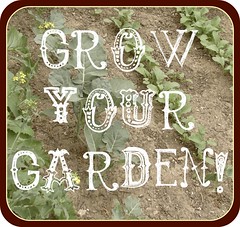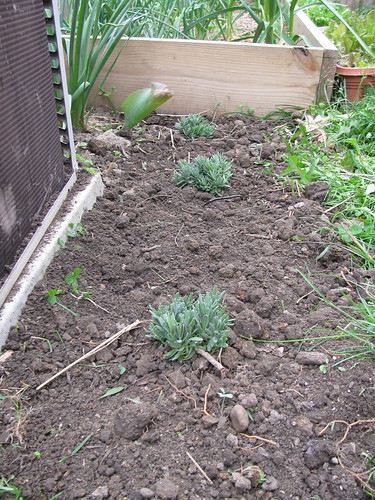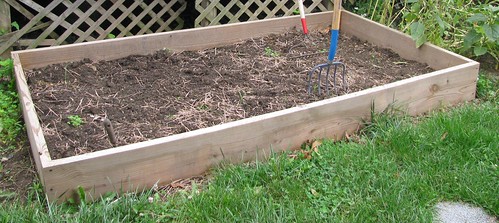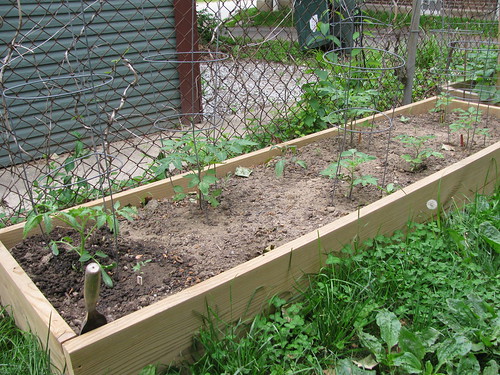 Now that you've decided what to plant and where to plant, it's time to build your beds!
The most basic technique for creating a garden bed is double digging. As the name implies, double dug beds are carefully turned with a garden shovel once over the whole surface. Some peat moss and/or compost can be sprinkled on top and then the whole bed is dug again. Each round of shoveling should be at least four inches deep.
Now that you've decided what to plant and where to plant, it's time to build your beds!
The most basic technique for creating a garden bed is double digging. As the name implies, double dug beds are carefully turned with a garden shovel once over the whole surface. Some peat moss and/or compost can be sprinkled on top and then the whole bed is dug again. Each round of shoveling should be at least four inches deep.
Our strawberries, garlic, and kale are all relegated to double dug beds. It takes me approximately 1 hour to double dig a 4 foot square bed. My body is achy for a few days after because double digging is hard work!! We line the beds with rocks or bricks if we have them to provide a visual reminder to little feet that plants are growing there.

A tiller will do the same job as a double digging in far less time with less effort. Most of us backyard gardeners do not have a gas powered tiller easy accessible, but they can be rented. We have never chosen a tiller to avoid the rental fee or the hassle of transporting it.
 The next common bed style is the raised bed. Here, sides are built from lumber and dirt is filled in the top. The Pioneer Woman has a great tutorial for building your own raised bed. We follow a similar procedure except we use 2x8 or 2x10s instead of using two layers of 2x4s for the sides.
The next common bed style is the raised bed. Here, sides are built from lumber and dirt is filled in the top. The Pioneer Woman has a great tutorial for building your own raised bed. We follow a similar procedure except we use 2x8 or 2x10s instead of using two layers of 2x4s for the sides.
Sides may be built from treated or untreated lumber, recycled plastic lumber, or cement blocks. Cedar is a naturally occurring wood that resists rot. Plastic lumber will last for a very long time, though it is heavy and costly to transport initially. Cement blocks are a popular choice at community gardens because they can be easily reconfigured or moved.
Some publications will tell you to avoid treated lumber at all costs. I was skeptical so I asked Alex, a material scientist by education and profession, to review research about the safety of treated lumber in the garden. He concludes that vegetables grown in treated lumber beds do not uptake the chemicals in treated lumber. While I still have hesitations about the worker safety of those who make treated lumber, we do use it for our raised beds because it is the cheapest long lasting material.
To anchor or not to anchor? Many plans recommend digging 6 to 12 inch holes and setting posts in them to anchor the sides of the raised bed. Others use stakes. We subscribed to this philosophy for the first few beds we made. It's not that hard, but we questioned why it was necessary.
 In our second round of bed building, we skipped the anchors. In our experience, the raised beds sides do not bow or move. The weight of the soil holds everything in place just fine. If you are looking to save some labor and cost, skipping the corner anchors might be a good choice.
In our second round of bed building, we skipped the anchors. In our experience, the raised beds sides do not bow or move. The weight of the soil holds everything in place just fine. If you are looking to save some labor and cost, skipping the corner anchors might be a good choice.
Soil for raised beds can be purchased from a plant nursery, the city, or a dirt and mulch company. If you have a hearty compost bin you can use that too. Last year we filled our beds with soil 'thrown' from the Jones topsoil Slinger truck. We mixed in our homegrown compost and some peat moss too. This year we will purchase some compost from Denise at 2Silos farm.
If double dug and raised beds aren't your style, there are alternative beds. You might plant in a bucket, straw bale, or potato tower. The most recent edition of Mother Earth News details a simple soil bag plan. Several companies make raised bed corners or corners and sides that gardeners need to simply assemble.
Are you building new beds this year? How are your existing beds made?
